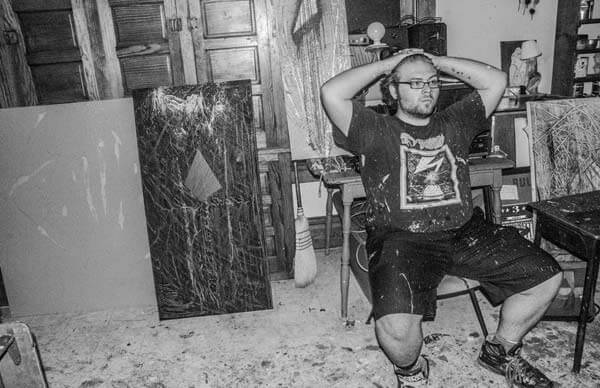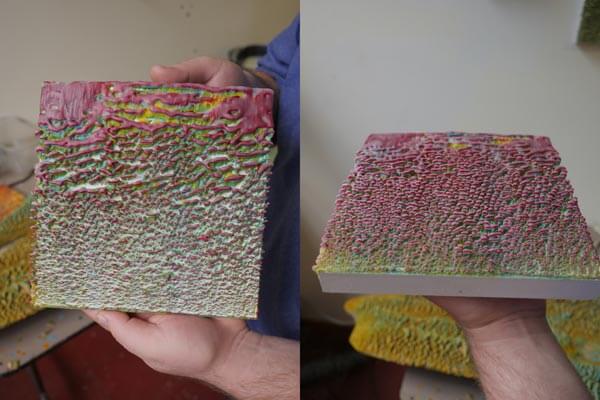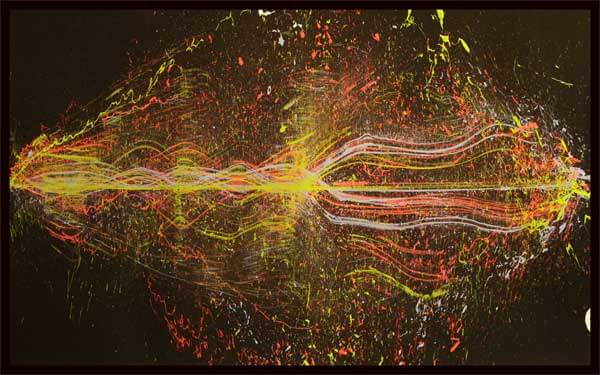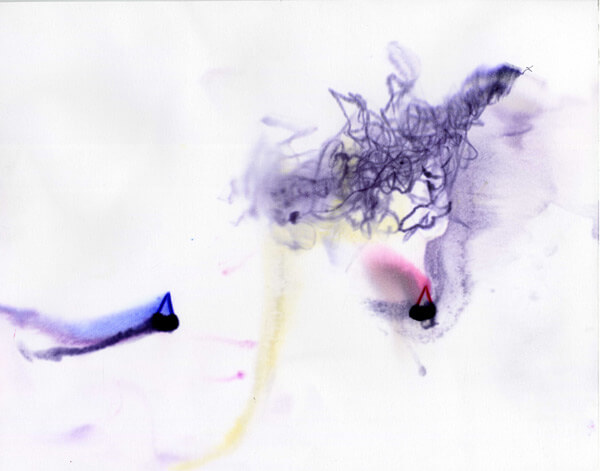Matthew Gallagher is a multifaceted artist working in a wide range of visual and sonic media. An Oberlin grad (Studio Art and Technology in Music and Related Arts), he is rapidly gaining traction in the Cleveland art world and is a frequent performer in the burgeoning experimental music scene.

Matthew Gallagher at 3 Door Studios, Oberlin (photo: Will Roane)
Your artistic instincts take you in multiple directions, what is the underlying aesthetic that motivates your work?
Discovery is the key word. No matter what media I’m working with, the process must be experimental, generative, and uncover more questions than answers. As an artist, I think of myself as a facilitator of reactions. My work is very formulaic, in that I design specific variables and then process them with some sort of chance influence to create a product. It’s an empowering spiritual practice for me. It allows me to pursue hypotheses and experiment in a non-institutional framework.
What led to your current sonic explorations you are pursuing as Machine Listener?
Machine Listener is the first serious solo recording project I’ve embarked on. It’s similar to my visual work in its exploratory nature. The name originated when I started taking field recordings of electromagnetic interference from household objects. Literally “listening” to machines do work. Computers, Wifi routers, anything with motors, light bulbs of all sorts, LED displays, etc. There are microscopic soundscapes surrounding us that can be made audible with pickups and a preamp. My intention to give a voice to these invisible soundscapes, acting as a facilitator and translator for the listener. As the project has evolved I’ve expanded the concept to include synths which I set up to play themselves using generative frameworks. My release Inner Beauty features this technique heavily. Each piece is a study in coaxing rhythms and melodies from the synth. My latest recording is similar, but features more post-processing and used a Roland JX-3P instead of a modular synth to generate material.

“Growth: Reef” encaustic on panel, 2014 (photo: Ryan Forte)
Your upcoming exhibition at River Gallery will feature your encaustic paintings; how does this media fit your aesthetic goals?
I think of my encaustic works as meditations. I can’t reveal exactly how they are made, but I use a cumulative, batch-based process of layering and color selection. There are infinite choices to make when using color in these pieces. It is a constant discovery to see one layer interacting with the previous. The piece changes dramatically with each layer added. Sometimes it does what I want, sometimes I am completely surprised at the outcome. The most recent evolution in this series has been more directed toward structural development of the substrate materials. These pieces have been incredibly problematic to present and conserve, as they are delicate and collect dust easily. I have started using an all plexiglass case/frame that facilitates illumination and greater viewing access with improved protection.

“Yonic Oscilllator” acrylic on paper, 2013 (photo: Matthew Gallagher)
Your works in acrylic paint have intense energy. How do you approach their creation?
These pieces are ultra-design based. I spend most of my time with these pieces planning the design narrative of their composition. The execution itself is fairly rapid. Acrylic paint dries relatively quickly, which allows layering and sharp edges. But once a choice is made with acrylics, it is difficult to undo. I think of these images as fossilized kinetic energy. My inspiration for this work began with the guitar. As I played I was entranced by the vibration of the strings and wanted to translate that energy into a 2-D surface. I tried to paint using a guitar string, but that proved too difficult. Instead, I began using an elastic band to transfer sonic energy into the paint. There’s a nice balance of chance and control in these pieces. The basic composition, color, and scale are conscious choices, but the actual paint marks made by the elastic are somewhat unpredictable. To me, these pieces are sonic art as much as visual art.

“Anomaly Series #6” ink and ethanol on Bristol, 2014 (photo: Matthew Gallagher)
Your solvent paintings have a special sort of immediacy; how do you create that effect?
Solvent paintings replace watercolor in my interest in fluid media. I’ve never found watercolor responsive enough. After learning about the use of chromatography in forensic science, I decided to try manipulating inks with more powerful solvents than just water. I was able to procure pharmaceutical grade ethanol, acetone, and petroleum ether to work with. There are so many brands of inks, each with different formulae, that it is a constant experiment each time I try a new ink or solvent. I’ve found that sharpie and ball-point pen ink yield the best results. Water-based acrylic inks are interesting as well, because they resist the solvent instead of blending with it. Once the solvent is introduced to the drawing it is important that the artist not manipulate the page, though I have begun to introduce small manipulative variables into the process. Many of these pieces draw influence from the Zen Buddhist tradition of Ensō-making, an amazing art-form that inspires much my work.
Upcoming Exhibitions:
Oberlin Connection at Sandusky Cultural Center, opening October 19, 2014
Encaustic Exhibit at River Gallery in Rocky River, Ohio, opening October 25, 2014



















